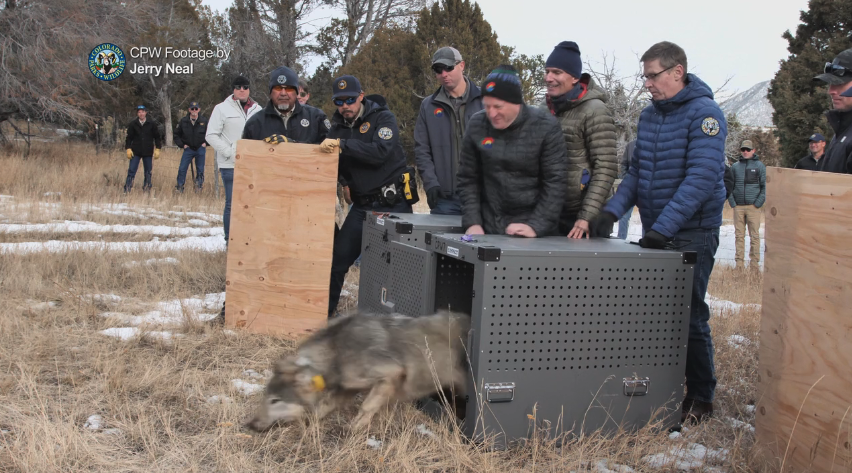WINTER PARK, Colo. — Colorado Parks and Wildlife is aware of one wolf den in Colorado this year, experts said during a CPW Commission meeting Thursday morning.
Reid DeWalt, CPW’s assistant director of aquatic, terrestrial, and natural resources, explained to the commissioners that biologists have not seen any wolf pups or the actual den, which he believes is on public land, “but the unique movement and behavior of the female is typical for a denning female, so there’s no other reason she would be doing what she is doing.” The biologists are working to confirm if she has reproduced. If a female did have pups, they are likely about 15 pounds as of now, DeWalt said.
Wolves typically give birth in April at a den, where the pups spend their first couple months of life. When they reach about eight weeks, the adults will move the pups to something called "rendezvous areas," which are similar to dens, but are more of a general shape at a fixed location where the pups can grow up and interact with the rest of the pack. These rendezvous areas have access to water, cover and lack of disturbances.

Local
Colorado's wolf conflict coordinator and ranchers work to find common ground
Over the following months, pups will begin to travel farther from the home site with the adult wolves.
Currently, Colorado is home to 11 known adult wolves — nine that were introduced in December and two that moved into Colorado previously. Two of them have non-functioning collars, but they are traveling with other wolves with working collars.
One of the introduced wolves was killed by a mountain lion in April, DeWalt said, adding that that is not a common occurrence. In addition, he said a wolf that died in Elbert County in April was not known by CPW, which is still working through that case. Genetic testing confirmed that animal was from the Great Lakes wolf population.
DeWalt also briefed the CPW Commission on conflict minimization regarding the wolves. As of Thursday morning, CPW has helped install five and a half miles of fladry — a line of bright, heavy-duty flags hung on a wire around a pasture — at four ranches in Colorado during the recent calving season.
At three locations where the fladry was installed, DeWalt said wolves were detected within 400 yards of the flags, but there were no livestock losses during that time.

"In one location, we had wolves that were detected once every six days for 42 days and once every three to four days for two weeks outside the fladry with no loss occurring," he said. "So, that’s a good sign that it is working."
In addition to the fladry, CPW has deployed 60 foxlights — which are light systems that blink in an irregular pattern, mimicking a person walking around — and numerous cracker shells. Authorities also issued nine permits that allow ranchers to use methods to potentially injure, but not kill, wolves. Technically called "potentially injurious non-lethal hazing permits," these allow ranchers to haze wolves when they are close to livestock or people.
Range riders are another conflict minimization technique that can work better than fladry in some cases, particularly in forested areas. CPW has collaborated with Working Circle, a Colorado nonprofit that has demonstrated success in range riding, to learn more about this tactic and how it can be applied in Colorado. The Colorado Department of Agriculture (CDA) is leading the charge with range riders.
These various methods are funded by the state, but it gets a boost from the sales of the Born to be Wild license plate, which funds deterrence and non-lethal conflict prevention work. DeWalt said the latest total generation is more than $200,000.
Watch Denver7's latest exclusive story on how the state's wolf conflict coordinator and ranchers have found common ground protecting livestock.
Current existing regulatory language allows for CPW or the U.S. Fish and Wildlife Service to remove a chronically depredating wolf, but if it does not have the resources, a rancher may be issued a permit for up to 45 days to do the same, said Travis Black, northwest region manager for CPW. He said the paperwork in that permit would have specific language about exactly which wolf is the problem so the rancher does not kill the wrong animal. However, as of now, Black said the agencies have the capacity to take care of this sort of problem on their own.
CPW's wolf team is also expanding as responsibilities increase. The department has hired two additional conflict specialists in the northwest region, with another hire coming soon to the southwest region. A new wolf conflict coordinator will be hired to specifically handle the claims and processing of claims after a wolf kills a livestock.
Lastly, DeWalt reviewed a new group of experts and community members who will come together three times this summer to provide input to CPW about how to build trust, decrease tensions, adjust conflict as it arises, and alternatives to addressing chronic depredation and when the agency should take action or issue a chronic depredation permit, which is outlined on page 5 of this CPW document.
As of the current plan, this Ad Hoc Working Group will consist of four individuals representing the cattle and sheep ranching community, four representatives of wolf restoration interests and four people representing CPW and CDA.
While the first of those meetings will not be open, DeWalt said he will discuss with the team about how to report its findings to the general public. After the three meetings, the takeaways will be presented to the Parks and Wildlife Commission, where the public can submit their comments.








